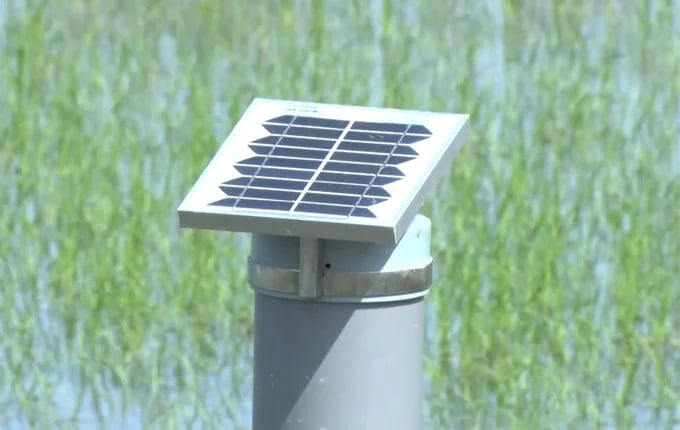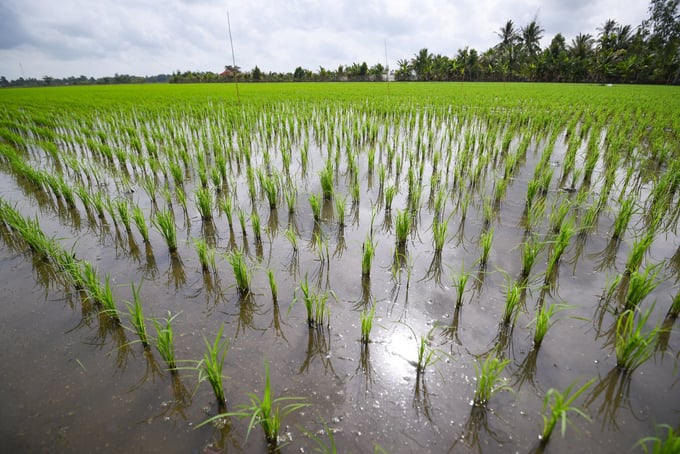November 21, 2025 | 07:39 GMT +7
November 21, 2025 | 07:39 GMT +7
Hotline: 0913.378.918
November 21, 2025 | 07:39 GMT +7
Hotline: 0913.378.918
The “One million hectares program specializing in high-quality, low-emission rice production” demonstrates Vietnam’s strong commitment of the entire rice sector to environmental and social responsibility.
One important tool for achieving this goal is the MRV process, which stands for Measurement, Reporting, and Verification. It forms the basis for creating legit carbon credits, opening the door for Vietnam to further participate in the international carbon market.
To realize this, it is necessary to standardize the MRV process related to environmental and sustainability indicators. A stable MRV system will increase the reliability between carbon sellers and buyers, bringing more benefits to farmers.
Vietnam Agriculture News reached out to experts in MRV and carbon markets to deliver information to farmers, cooperatives, businesses, and rice scientists, empowering them to make proactive decisions and promote the green transition of the rice sector.

When emission reduction technologies are applied, it is necessary to validate that the farmers have implemented them. Photo: Kim Anh.
What can we expect based on the specific results we have achieved from implementing the MRV process in rice production in certain localities?
Dr. Mai Van Trinh (Director of the Institute of Agricultural Environment):
The purpose of MRV is to provide validation that a locality has implemented emission reduction tasks for the nation or that the nation has applied emission reduction technology on a certain scale and reduced emissions by a specific amount for international recognition.
Furthermore, practitioners of emission reduction technologies will be certified and issued credits indicating how much they have reduced, the scale of the reduction, the technology applied, and the number of carbon credits achieved. They will receive a certification that is recognized in both domestic and international carbon markets.
Therefore, when emission reduction technologies are applied, it is necessary to validate that the farmers have implemented them and that this implementation is recognized nationally, internationally, or by carbon credit buyers.
MRV is always essential in these activities and must always accompany greenhouse gas emission reduction efforts. Wherever there is a reduction in greenhouse gas emissions, MRV must be present. The role of MRV is crucial for transparency, accuracy, and ultimately providing real value to producers.
By applying GHG emission reduction measures, they are acknowledged for their participation in reducing emissions and mitigating climate change, and they can trade their emission reduction results for financial gain.
For instance, entities with emission allowances that exceed their reduction targets can trade their surplus with entities that do not meet their allowances, or with voluntary participants outside the regulated quota system. This trading creates a significant source of revenue for production units.
Based on Dr. Trinh’s perspectives on the MRV process needing to be implemented on large-scale model fields, and the initial results from the consolidation and evaluation phase of 180,000 hectares of VNSAT within the 1 Million Hectares Project, what further support do you believe the Government needs to provide to facilitate low-emission production across the 1 million hectares?
Dr. Tran Cong Thang (Director of the Institute of Policy and Strategy for Agricultural and Rural Development):
Particularly in this project, we see an advantage: a strong consensus from central to local levels, with excellent coordination between the Ministry of Agriculture and the localities and cooperatives. However, there are still some policies needed. If we could increase the financial support for rice-growing households.
Previously, we set the support at 1 million VND per hectare, but we could increase this amount to help the provinces gain more investment capital. This money wouldn’t be given directly to farmers but would be used by the provinces, along with other support funds, to invest in infrastructure, especially irrigation systems, or to provide additional training for cooperatives and farmers.
Moreover, we need several other policies, such as supporting the development of a low-emission rice brand that could certainly be sold at a higher price. This is a very important policy.

Policymakers should support farmers and cooperatives to purchase rice insurance. Photo: Tung Dinh.
Additionally, there is an existing policy on agricultural insurance, but it faces many implementation challenges. Rice is one of the products prioritized by the government, but its implementation has been difficult. While developing this project, we should support farmers and cooperatives to purchase rice insurance, giving them more peace of mind.
The fourth, and what I think is the most important, is the Ministry of Agriculture’s strong determination to collaborate with the World Bank and other organizations to build loan projects. This partnership with other activities will enable us to develop more rapidly.
Our goal is sustainable development, so international cooperation solutions are crucial. Recently, the Ministry of Agriculture has been very proactive in communicating and securing commitments for projects. We need to work together with the Ministry of Agriculture to build models or apply low-emission solutions.
Finally, to support low-emission producers, we need a program to support trade promotion in addition to certification. This means supporting businesses and cooperatives so that they can have better market access once they have certification.
We can change consumer perceptions by doing this. When consumers see sustainable or low-emission rice labels, they will be more willing to buy them. Of course, the quality must be good, but when consumers see those labels, they will feel that they are contributing to emission reduction and supporting sustainability by purchasing them.
The MRV process and the carbon market have a symbiotic relationship, where MRV provides a reliable data foundation for the creation and trading of carbon credits, thereby promoting greenhouse gas emission reduction activities and sustainable development. Investors and businesses purchasing credits need assurance that the carbon credits they buy are based on genuine emission reduction activities.

(VAN) This is the study conducted by IRRI and Can Tho University on the rice straw value chain in Mekong Delta showing an economic potential of more than 6.6 trillion VND/year.

(VAN) By participating in cooperative economics, many farmers in Tay Ninh have overcome hardship, mastered clean dragon fruit cultivation techniques.

(VAN) The crossbreeding program in the former Binh Dinh province (now part of Gia Lai) has shown signs of decline, and urgent measures are needed to revive it and sustain past achievements.

(VAN) The agricultural sector agreed on a roadmap to pilot the MRV protocol and expand low-emission rice production from the 2025-2026 winter-spring crop.

(VAN) Agricultural extension officers in Quang Ninh do more than transmit knowledge; they have become a steadfast support system for farmers on the path to sustainable agricultural development.

(VAN) The development of a high-quality beef cattle herd has brought major benefits to livestock farmers, creating jobs and enabling better use of agricultural by-products.

(VAN) In the eastern region of Gia Lai, crossbred cattle now account for 93%, forming a high-quality beef herd and establishing a recognized brand, the result of 35 years of persistent effort.